Siege Warfare and Fortifications
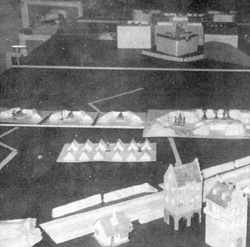 Looking from behind the besiegers, the first photo shows gun
emplacements along the first parallel--the zig-zag of the saps are shown
moving towards the position of the Second parallel, which is already marked in
this scene.
Looking from behind the besiegers, the first photo shows gun
emplacements along the first parallel--the zig-zag of the saps are shown
moving towards the position of the Second parallel, which is already marked in
this scene.
The siege game is played under Le Kriegspiel rules, but with the following clarifications, exceptions and additons:
1. The players may support guns with less than a full tactical unit (a battalion) of infantry.
2. The players may maintain a portion of any unit of skirmishers as a formed reserve, but the bases of this formed part shall be touching.
3. Two units may be placed within a polygon in battle order if both are in column.
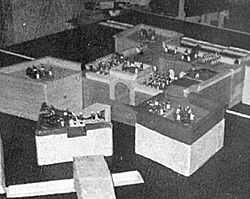 The photo above shows the fort, a model manned with 23mm figures. The line of stonework about 3/4 of the way up on the near bastion shows the approximate height to which a "glacis" might reach.
The photo above shows the fort, a model manned with 23mm figures. The line of stonework about 3/4 of the way up on the near bastion shows the approximate height to which a "glacis" might reach.
4. Field Artillery Rules:
- a. At short range (less than 5 polygons) the first salvo requires a
4, 5, or 6 for a hit.
b.At short range the second salvo requires a 2, 4, 5, or 6 for a hit against all targets moving at infantry speed or standing. Otherwise it is scored as above.
c. At long: range (5 to 8 polygons) the first salvo requires a 6 for a hit. The second requires a 5 or 6 to register a hit, at targets moving at infantry speed or less. Otherwise it is scored as above.
d. The use of grapeshot and canister gives guns another die at distances or 3 polygons or less. Howitzers require a 5 or 6 at ranges of 0 to 4 polygons, or a 6 at ranges of 4 to 5 polygons, in order to score a hit. They may set fire to buildings (but not bombproofs, etc.). Players will then roll the die to see how long the structure burns. When howitzers fire canister they are scored In the same way as guns.
f. Guns may breech house walls in line of sight with a 6 confirmed by a 4, 5 or 6. This reduces the defensive advantage of the structure to 6 points after 3 hits.
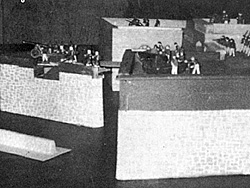 This photo shows a close up of the redoubt covering the main gate. This work can provide flanking fire on attackers aiming at the bastions on either side, and permits the entrance to be placed high on the works. It can, however, be entirely dominated by the works themselves if taken.
This photo shows a close up of the redoubt covering the main gate. This work can provide flanking fire on attackers aiming at the bastions on either side, and permits the entrance to be placed high on the works. It can, however, be entirely dominated by the works themselves if taken.
5. Siege Artillery Rules:
- a. Siege guns -- artillery of 18 pdr calibre or above -- are required to breech masonry walls 7 or more feet thick.
b. Range of these guns equals 10 polygons, but breaching distance is 6 polygons or under.
c. Only direct fire may be used to breech fort wells.
d. Siege guns either fire or move once a turn, they cannot do both.
e. Movement for siege artillery is at infantry speed.
f. At breeching distance of 6 to 4 polygons, a die roll of 6 begins the breech. Thereafter a 5 or a 6 count. At 3 polygons or less a 5 or 6 begins the breech, and thereafter a 4, 5, or 6 count. An effective roll is presumed to penetrate 235 feet of masonry. Thus 6 rolls are needed to breech a 7 foot scarp for a space one polygon wide.
g. Artillery counter battery fire: At ranges of 7 to 6 polygons a die roll of 6 confirmed by 6 dismounts an embrasure mounted piece, or a barbette gun. At ranges of 6 to 4 polygons, a 6 confirmed by 6 dismounts an embrasure mounted piece, a 1; confirmed by a 5 or 6 dismounts a barbette gun. Unconfirmed hits at 6 to 4 polygons are scored against the crews if the roll equal 4 or more, at 3, any score. Casemate Puns may he dismounted at ranges of 4 polygons or less if the firer rolls a 6 confirmed by a 6, confirmed even (an embrasure shot). Otherwise they may be dismounted by breeching the walls protecting then..
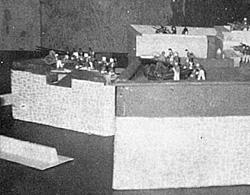 The fort shown from the side. The major guns in the near bastion and outwork are permanent fortification pieces(Thomas K&L 32pdrs.) while those on the field carriages are mobile pieces thrown into the fort as a reinforcement.
The fort shown from the side. The major guns in the near bastion and outwork are permanent fortification pieces(Thomas K&L 32pdrs.) while those on the field carriages are mobile pieces thrown into the fort as a reinforcement.
h. Heavy caliber guns roll 3 dice per gun for grape and canister fire against exposed personnel.
i. Heavy mortar range is 10 Polygons, light mortar range is the same as that of field artillery. A 6 confirmed by an even number gives a hit, which may be scored against buildings in the same way as a field howitzer hit, or against personnel, Mortars cannot fire at targets closer than 2 polygons or use grape and canister. Heavy howitzers have the same ranges as mortars but may use grape and canister.
j. Richochet fire: When a player's battery takes his opponent's guns in enfilade (a 90 degree angle w. flank), he may employ richochet fire. This is the same as normal fire except that every battery gaining the benefit rolls three times, unless a hit is registered before. This Is done to simulate the effect of solid shot ricocheting and passing through a line of batteries. Ricochet fire is ineffectual if the batteries are protected by traverses.
k. Maximum gun traverse: Open batteries, embrasure mounted batteries have a maximum traverse of 45 degrees a move, barbette guns, 180 degrees.
l. Artillery fire is otherwise the same as for field guns.
m. Swivel guns have the same maximum range as field howitzers.
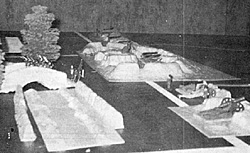 Looking down the gun line at the first parallel. Opposite the bridge is the "Royal" or "Grand" battery.
Looking down the gun line at the first parallel. Opposite the bridge is the "Royal" or "Grand" battery.
6. Escalades: The defenders against an escalade, if in a permanent fort add 44 points per tactical unit. Parts of a unit add their due proportion.
7. The defenders of field works have a 24 point advantage, of houses, 12
8. At night all artillery fire is limited to 4 polygon range at 6 only.
9. Storming breeches. The defenders of a breach add 12 points per tactical unit, if In a permanent work.
10. Infantry fire has no effect on the defenders of horses, field or permanent works.
11. Troops occupying positions atop a ramp have a 3 point advantage, behind a barrier thrown across a gorge, a 6 point advantage.
12. Engineers may prepare mines for a breach. Mines are dug at the rate of 1/20 a polygon per move. When the mine is finished the attacker rolls a pair of dice and a 5 or 6 effects a breach. Any other score assumes discovery. Troops on the blasted section lose 1 and retreat in disorder.
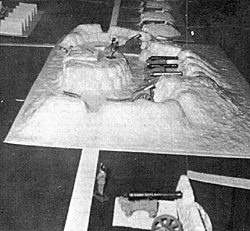 Close up of the "Royal" battery. The large seige guns have bean mounted in the works on non-mobile carriages. Cannon barrels my be seen to the rear of the work which are part of the artillery park and have not yet been mounted in position. The howitzers on the flanks, on the other hand, are heavy field howitzers capable of being manuevered fairly rapidly.
Close up of the "Royal" battery. The large seige guns have bean mounted in the works on non-mobile carriages. Cannon barrels my be seen to the rear of the work which are part of the artillery park and have not yet been mounted in position. The howitzers on the flanks, on the other hand, are heavy field howitzers capable of being manuevered fairly rapidly.
13. Batteries: A siege battery can be constructed in a night's time (16 moves) by a four figure unit.
14. Saps and parallels: Sappers push their trenches forward at the rate of 3 polygons a night if not impeded by fire. otherwise the advance is reduced a third. Each sap requires the same size working party as a battery.
15. Repairs:
- a. Breaches may be repaired after 12 moves of uninterrupted work.
b. Parapets may be restored after two moves of uninterupted work.
c. Batteries may be remounted after 5 moves work.
d. The work force must equal four figures per task.
16. General:
- a. The defender of a work may split up his unit as he chooses.
b. Defending units may adopt any formation required to conform to the layout of the works and provide effective defence.
c. Provisional or mixed units may be formed by massing flank or artillery companies, etc** at any time prior to the enemy's entry into the works.
d. The fortress proper is considered the defender's base of operations.
Siege Warfare and Fortifications
Back to The Armchair General Vol. 2 No. 5 Table of Contents
Back to The Armchair General List of Issues
Back to MagWeb Master Magazine List
© Copyright 1970 by Pat Condray
This article appears in MagWeb (Magazine Web) on the Internet World Wide Web. Other military history articles and gaming articles are available at http://www.magweb.com
